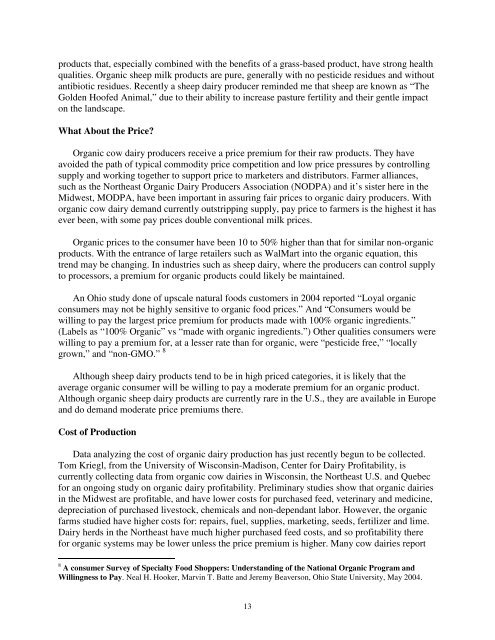great lakes dairy sheep symposium - the Department of Animal ...
great lakes dairy sheep symposium - the Department of Animal ...
great lakes dairy sheep symposium - the Department of Animal ...
Create successful ePaper yourself
Turn your PDF publications into a flip-book with our unique Google optimized e-Paper software.
products that, especially combined with <strong>the</strong> benefits <strong>of</strong> a grass-based product, have strong health<br />
qualities. Organic <strong>sheep</strong> milk products are pure, generally with no pesticide residues and without<br />
antibiotic residues. Recently a <strong>sheep</strong> <strong>dairy</strong> producer reminded me that <strong>sheep</strong> are known as “The<br />
Golden Ho<strong>of</strong>ed <strong>Animal</strong>,” due to <strong>the</strong>ir ability to increase pasture fertility and <strong>the</strong>ir gentle impact<br />
on <strong>the</strong> landscape.<br />
What About <strong>the</strong> Price?<br />
Organic cow <strong>dairy</strong> producers receive a price premium for <strong>the</strong>ir raw products. They have<br />
avoided <strong>the</strong> path <strong>of</strong> typical commodity price competition and low price pressures by controlling<br />
supply and working toge<strong>the</strong>r to support price to marketers and distributors. Farmer alliances,<br />
such as <strong>the</strong> Nor<strong>the</strong>ast Organic Dairy Producers Association (NODPA) and it’s sister here in <strong>the</strong><br />
Midwest, MODPA, have been important in assuring fair prices to organic <strong>dairy</strong> producers. With<br />
organic cow <strong>dairy</strong> demand currently outstripping supply, pay price to farmers is <strong>the</strong> highest it has<br />
ever been, with some pay prices double conventional milk prices.<br />
Organic prices to <strong>the</strong> consumer have been 10 to 50% higher than that for similar non-organic<br />
products. With <strong>the</strong> entrance <strong>of</strong> large retailers such as WalMart into <strong>the</strong> organic equation, this<br />
trend may be changing. In industries such as <strong>sheep</strong> <strong>dairy</strong>, where <strong>the</strong> producers can control supply<br />
to processors, a premium for organic products could likely be maintained.<br />
An Ohio study done <strong>of</strong> upscale natural foods customers in 2004 reported “Loyal organic<br />
consumers may not be highly sensitive to organic food prices.” And “Consumers would be<br />
willing to pay <strong>the</strong> largest price premium for products made with 100% organic ingredients.”<br />
(Labels as “100% Organic” vs “made with organic ingredients.”) O<strong>the</strong>r qualities consumers were<br />
willing to pay a premium for, at a lesser rate than for organic, were “pesticide free,” “locally<br />
grown,” and “non-GMO.” 8<br />
Although <strong>sheep</strong> <strong>dairy</strong> products tend to be in high priced categories, it is likely that <strong>the</strong><br />
average organic consumer will be willing to pay a moderate premium for an organic product.<br />
Although organic <strong>sheep</strong> <strong>dairy</strong> products are currently rare in <strong>the</strong> U.S., <strong>the</strong>y are available in Europe<br />
and do demand moderate price premiums <strong>the</strong>re.<br />
Cost <strong>of</strong> Production<br />
Data analyzing <strong>the</strong> cost <strong>of</strong> organic <strong>dairy</strong> production has just recently begun to be collected.<br />
Tom Kriegl, from <strong>the</strong> University <strong>of</strong> Wisconsin-Madison, Center for Dairy Pr<strong>of</strong>itability, is<br />
currently collecting data from organic cow dairies in Wisconsin, <strong>the</strong> Nor<strong>the</strong>ast U.S. and Quebec<br />
for an ongoing study on organic <strong>dairy</strong> pr<strong>of</strong>itability. Preliminary studies show that organic dairies<br />
in <strong>the</strong> Midwest are pr<strong>of</strong>itable, and have lower costs for purchased feed, veterinary and medicine,<br />
depreciation <strong>of</strong> purchased livestock, chemicals and non-dependant labor. However, <strong>the</strong> organic<br />
farms studied have higher costs for: repairs, fuel, supplies, marketing, seeds, fertilizer and lime.<br />
Dairy herds in <strong>the</strong> Nor<strong>the</strong>ast have much higher purchased feed costs, and so pr<strong>of</strong>itability <strong>the</strong>re<br />
for organic systems may be lower unless <strong>the</strong> price premium is higher. Many cow dairies report<br />
8 A consumer Survey <strong>of</strong> Specialty Food Shoppers: Understanding <strong>of</strong> <strong>the</strong> National Organic Program and<br />
Willingness to Pay. Neal H. Hooker, Marvin T. Batte and Jeremy Beaverson, Ohio State University, May 2004.<br />
13
















